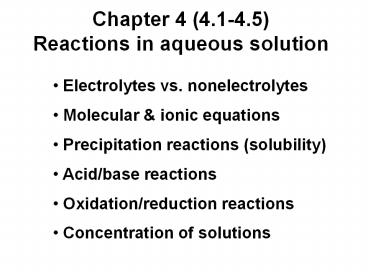Chapter 4 (4.1-4.5) Reactions in aqueous solution - PowerPoint PPT Presentation
Title:
Chapter 4 (4.1-4.5) Reactions in aqueous solution
Description:
A solution is a homogenous mixture of 2 or more substances. The solute is(are) the substance(s) ... Soft Solder (s) H2O. N2. Pb. Sugar, CO2. O2, Ar, CH4. Sn ... – PowerPoint PPT presentation
Number of Views:15
Avg rating:3.0/5.0
Title: Chapter 4 (4.1-4.5) Reactions in aqueous solution
1
Chapter 4 (4.1-4.5)Reactions in aqueous solution
- Electrolytes vs. nonelectrolytes
- Molecular ionic equations
- Precipitation reactions (solubility)
- Acid/base reactions
- Oxidation/reduction reactions
- Concentration of solutions
2
A solution is a homogenous mixture of 2 or more
substances
The solute is(are) the substance(s) present in
the smaller amount(s)
The solvent is the substance present in the
larger amount
Soft drink (l)
H2O
Sugar, CO2
Air (g)
N2
O2, Ar, CH4
Pb
Sn
Soft Solder (s)
3
An electrolyte is a substance that, when
dissolved in water, results in a solution that
can conduct electricity.
A nonelectrolyte is a substance that, when
dissolved, results in a solution that does not
conduct electricity.
4
Cations () and Anions (-) conduct electricity
in solution
Strong Electrolyte 100 dissociation
Weak Electrolyte not completely dissociated
5
Ionization of acetic acid
CH3COOH CH3COO- (aq) H (aq)
Acetic acid is a weak electrolyte because its
ionization in water is incomplete.
6
Nonelectrolytes do not conduct electricity
No cations () and anions (-) in solution
7
So how do you know if it is a strong, weak, or
non-electrolyte?
- Molecular compounds are non.
- Ionic compounds are strong or weak.
- ALL insoluble cpds are weak.
- MOST soluble cpds are strong.
- Memorize exceptions.
- Some acids and bases
- H2O
- NH3
- And more that I wont ask you to memorize
8
General solubility rules for salts
Soluble All nitrates (NO3-), bicarbonates (HCO3-) and chlorates (ClO3-) All acetates (C2H3O2- or CH3COO-) except Ag All halides (Cl-, Br-, I-) except Ag, Pb2, Hg22 All sulfates (SO42-) except Ag, Ca2, Sr2, Ba2, Pb2, Hg22 All alkali metal ion (Na, K, Rb, Li, Cs), NH4 salts All common inorganic acids
Insoluble All hydroxides (OH-) except alkali metal ions, NH4, Ba2 All chromates (CrO4-), carbonates (CO32-), phosphates (PO43-), and oxalates (C2O42-) except alkali metals and NH4 All sulfides (S2-) except Na, K, NH4, Mg2, Ca2, Ba2
9
Some common strong electrolytes Some common strong electrolytes Some common strong electrolytes
Acids HCl HNO3 H2SO4 HClO4 Bases NaOH KOH Ba(OH)2 Etc Salts all soluble salts with a few exceptions, see below.
Some common weak electrolytes Some common weak electrolytes Some common weak electrolytes
Acids HC2H3O2 HF HNO2 H3PO4 H2C2O4 H2SO3 H2CO3 H2S Bases NH3 Mg(OH)2 Ca(OH)2 Fe(OH)3 etc Salts/other HgCl2 Pb(C2H3O2)2 H2O etc
10
Three types of reactions in aqueous solution (in
this chapter)
- Precipitation reactions
- Acid/base reactions
- Oxidation/reduction reactions
11
Precipitation Reactions
Precipitate insoluble solid that separates from
solution
molecular equation
ionic equation
net ionic equation
Na and NO3- are spectator ions
12
Writing Net Ionic Equations
- Write the balanced molecular equation.
- Write the ionic equation showing the strong
electrolytes completely dissociated into cations
and anions. Do NOT dissociate weak electrolytes. - Cancel the spectator ions on both sides of the
ionic equation
13
Three types of reactions in aqueous solution (in
this chapter)
- Precipitation reactions
- Acid/base reactions
- Oxidation/reduction reactions
14
Arrhenius acid is a substance that produces H
(H3O) in water
Hydronium ion
Arrhenius base is a substance that produces OH-
in water
15
A Brønsted acid is a proton donor A Brønsted base
is a proton acceptor
acid
base
acid
base
A Brønsted acid must contain at least one
ionizable proton!
16
Identify each of the following species as a
Brønsted acid, base, or both. (a) HI, (b)
CH3COO-, (c) H2PO4-
Brønsted acid
Brønsted base
Brønsted acid
Brønsted base
17
Monoprotic acids
Strong electrolyte, strong acid
Strong electrolyte, strong acid
Weak electrolyte, weak acid
Diprotic acids
Strong electrolyte, strong acid
Weak electrolyte, weak acid
Triprotic acids
Weak electrolyte, weak acid
Weak electrolyte, weak acid
Weak electrolyte, weak acid































